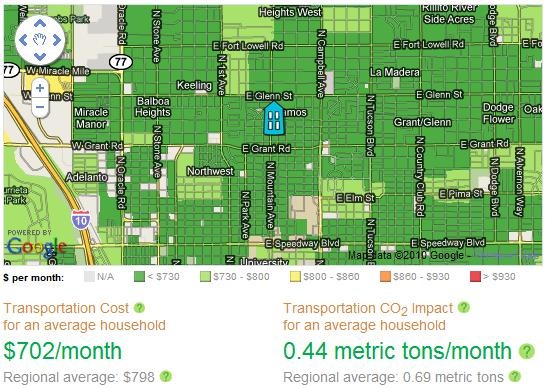Our friends at GOOD magazine turned me on to this really cool tool by the Center for Neighborhood Technology. The "Abogo" (as they call it) calculates the transportation costs in your area and then estimates the size of your carbon footprint (and yes, they do explain their methodology).
I just moved from urban San Francisco to suburban Palo Alto, and I was not surprised by the comparison that emerged.
In my former densely populated, walkable San Francisco neighborhood, Abogo estimates that each resident spends an average of $664 a month (against a regional average of $792) and generates .34 metric tons of carbon a month (nearly half the regional average). (Since we didn't own a car, my family spent considerably less than that a month, about $160 for MUNI passes, BART rides, and cabs.)
What about my new, leafy suburb in Palo Alto? Abogo estimates that my neighbors spend $797 a month (pretty much the regional average) and generate .44 metric tons of carbon. Again, that feels about right. Everyone here has a car except for us, though bicycling is popular in this college town. (Incidentally, Palo Alto public transit is horribly expensive–my wife and son spent $15 traveling two miles. If Palo Alto wants to cut its carbon footprint, the city might consider slashing the cost of transit.)
What happens when the population becomes even less dense? This morning, I biked out to nearby Woodside, an affluent, exurban community, where you need to get in the car to buy a carton of milk. A Woodside resident, I discovered, can expect to spend a stunning $1068 a month on transportation and generate nearly one metric ton of carbon per month–that's triple what a San Franciscan generates.
How affordable and sustainable is your neighborhood?
Lest I be accused of San Francisco chauvinism, I compared it to Portland, OR, generally considered America's most shareable, transit-friendly city–and found that residents there spend a mere $469 a month and generate .18 metric tons of carbon. Think about it: According to this estimate, Woodside is generating five times more carbon than Portland. Even New York makes more of an impact on the atmosphere: Each New Yorker only spends $288/month, but generates .29 metric tons of carbon. Good planning gets good results, cutting costs as well as carbon.
Back in September of last year, we published an interview with author David Owen about his book Green Metropolis, which argues that the best way to achieve sustainability "is through thoughtful urbanization—by moving people closer together and getting them to share what they have." Since then, I've been consistently surprised at how resistant people are to the notion that the dense cities are more sustainable than the country. But it's really not rocket science: In dense cities, people live in apartments and they're more likely to walk because the stuff they need is close by; in places like Woodside, you kind of need a car, and homes tend to be a lot bigger. Cities are just more efficient because the people in them consume less energy on a per capita basis. Abogo is a great tool for helping us to understand that fact.
BTW, the CNT also has a really neat page that suggests ways to lower your transportation costs, largely by sharing transportation.









